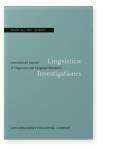Vol. 44:1 (2021) ► pp.37–65
The past participle and the periphrastic passive construction in French
Our hypothesis is that the past participle is a singular form in the TAM (tense-aspect-mood) linguistic system in French, in that it represents the internal time of the process on its terminal point ([R = Et]). Due to this representation of internal time, the p.p. can be related to the second argument – the patientive argument – of a direct transitive process: it is the essential element of the passive construction. Contrary to what is often written, the copula être ‘be’, is an optional element: it may serve to develop the construction in its periphrastic dimension, but it is not necessary to the passive construction itself, as the cases of the passive in the participial clause demonstrate. Moreover, the p.p. is not intrinsically resultative or processive, no more than it is active or passive: from its aspect [R = Et], it can, in interaction with different contexts, participate in the production of these different effects of meaning in discourse.
Article outline
- Introduction
- 1.The aspectual singularity of the past participle
- 1.1Internal time, tension and aspect of the p.p.
- 1.2Aspect of the p.p. and aspect of other verbal forms
- 2.Uses of the past participle in discourse
- 2.1The p.p. in the participial clause
- 2.2The p.p. in the analytic construction
- 3.The p.p. in the periphrastic passive construction
- 3.1The periphrastic passive construction and the analytic construction
- 3.2 Être in the passive construction: auxiliary or copula?
- 3.3Is the p.p. in the passive construction passive?
- 3.4
Resultative meaning and processive meaning
- 3.4.1Telic processes
- 3.4.2Atelic processes
- Conclusion
- Acknowledgements
- Notes
-
References
